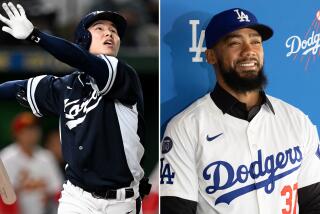Pirates Have Added Power to the Lineup, Now What They Want Is Few More Fans
- Share via
PITTSBURGH — By acquiring three power-hitting veteran outfielders in off-season deals, Harding “Pete” Peterson, the Pittsburgh Pirates’ general manager, is looking to put more baseballs--and more fans--into Three Rivers Stadium’s outfield seats. Last season, when they finished in last place for the first time since 1955, the Pirates were anemic at both the plate and the turnstiles. If their cumulative .255 batting average and 98 home runs weren’t offensive enough to Peterson, then a National League-low attendance of 773,500 was.
After the Pirates ended a dismal 75-87 season, 21 1/2 games behind the National League East-winning Chicago Cubs, Peterson vowed to turn the team that was jokingly nicknamed the Slumber Company back into the Lumber Company.
Peterson, by using the lame duck money of outgoing owner John W. Galbreath to obtain Sixto Lezcano, Steve Kemp and George Hendrick, thinks he has kept that promise. And he hopes to have reversed a recent trend that has seen the Pirates make a series of embarrassing, and expensive, front office mistakes.
The Pirates, who lost a reported $6 million in 1984, frittered away hundreds of thousands of dollars to acquire aging free agents Gene Tenace and Amos Otis, both of whom were soon released, and to trade for non-productive outfielder Lee Mazzilli.
Now, with a league-leading pitching staff kept almost intact despite his dealing, Peterson’s new victory equation is power plus pitching equals more victories and more home runs--and more fans.
“In baseball, there’s no substitute for winning to attract more fans,” Peterson said. “If you hit more home runs, you win more games and excite the fans. And hopefully, more of them come to the ballpark.”
Manager Chuck Tanner has seen the Pirates evolve from a team that won games with the long ball to one that stressed speed and timely hitting to one that needed three hits in a row to score a run.
“I’m not saying we’re back to where we were with Dave Parker and Willie Stargell and Bill Robinson, but I think we’re close,” Tanner said. “We’re back to where we’ve got some firepower to generate runs. We’re not going to need three singles to score a run any more. I’m talking two-run homers, I’m talking three-run homers.”
Lezcano’s acquisition could be more valuable than it first appears.
Although Kemp and Hendrick will be everyday players, both are in their 30s and neither will play 162 games. Lezcano not only is an offensive weapon--he had 14 homers in just 265 at-bats last season--he has a strong throwing arm, something the Pirates have lacked since Dave Parker signed with the Cincinnati Reds as a free agent.
Lezcano also plays best when given frequent slaps on the back, which he will get plenty of from the always-optimistic Tanner.
“We’ve got the power to generate runs now and that’s got to be better for our pitchers,” Tanner said. “Last year, we would have won a lot more games if we had just made the routine plays. We’ve got the guys now who can make the plays.”
Hendrick has been one of baseball’s most productive players for a decade, and Kemp had several outstanding seasons with the Detroit Tigers and Chicago White Sox until being relegated to the New York Yankees’ bench.
First baseman Jason Thompson has had a pair of off-seasons after belting 31 homers in 1982. But Tanner and Peterson believe that with a pair of .300 hitters, Johnny Ray and Bill Madlock, in front of him, and Kemp, Hendrick and Tony Pena--and, often, Lezcano--batting behind him, Thompson will be more productive.
The Pirates also have more maneuverability. Thompson can be rested more often, particularly against difficult left-handers, with Hendrick moving to first base and Lezcano playing in right.
“We’re going in the right direction,” Tanner said.
More to Read
Go beyond the scoreboard
Get the latest on L.A.'s teams in the daily Sports Report newsletter.
You may occasionally receive promotional content from the Los Angeles Times.









